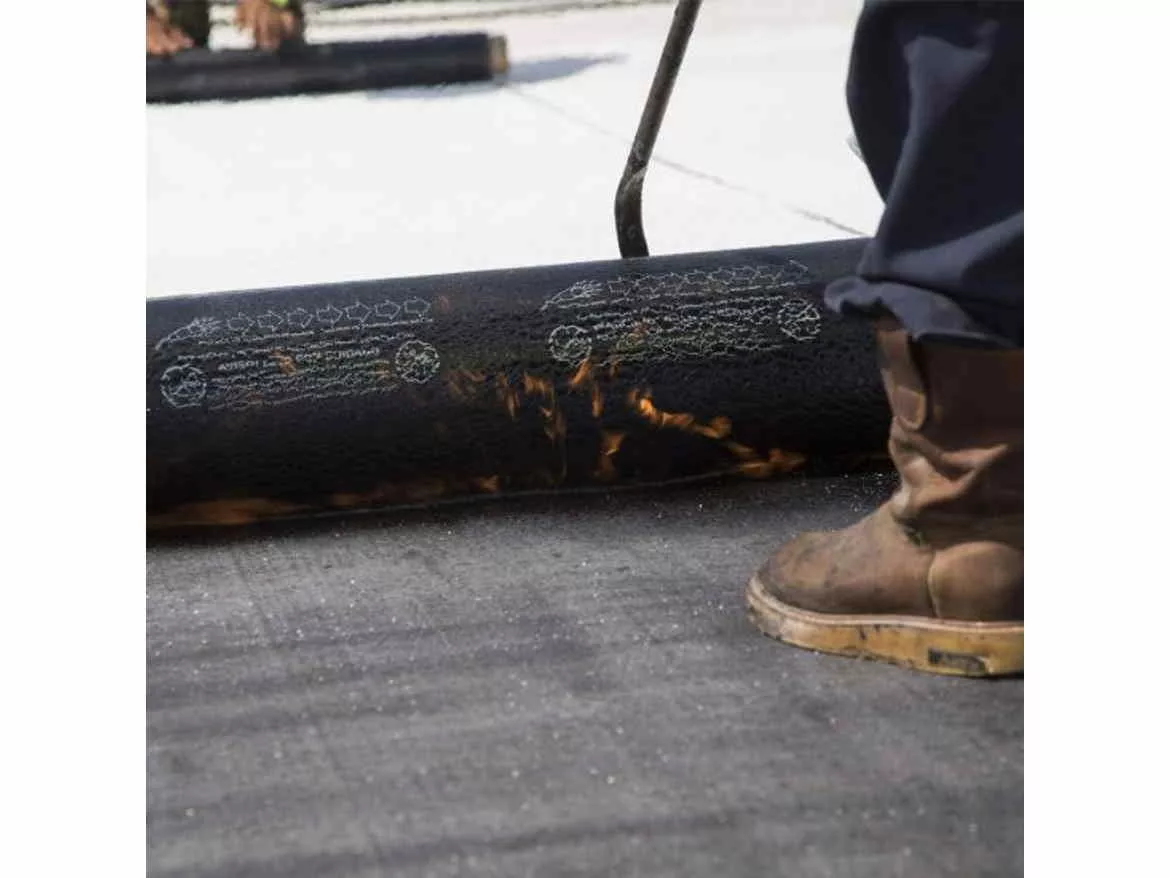Fit for Mod-Bit

Presented by the Asphalt Roofing Manufacturers Association
With a long history of success in Europe, the United States, Canada, and elsewhere, the market presence of the SBS modified bitumen roofing product family has remained strong. While non-residential new construction spending in the United States was down year over year (YOY) from 2019 to 2020, SBS modified bitumen was the only roofing product category that enjoyed YOY growth in shipments in this same period.
Since their introduction in Europe in the late 1960s and in the U.S. in the late 1970s, SBS modified bitumen roof membrane systems have provided superior protection against a variety of external forces and natural elements. Although these low-slope membrane systems have been around for nearly 50 years, SBS membrane designs have adapted to meet the demands for safer and faster installations, and now meet the rigors of modern sustainable and cool roof design criteria around the world.
One driving factor is that SBS modified bitumen roof membranes provide robust low-slope roofing solutions on buildings where redundant long-term protection of the structure, its contents, and the occupants is the primary concern. With the increased push for sustainability and the need for longer-lasting roof systems, it’s no surprise that the industry shipment reports showed this growth for SBS modified bitumen, while other roof membrane category shipments declined in 2020.
As the roofing industry continues to work to improve the sustainability of the industry’s products and to reduce the negative impacts of those products on the environment and the health and comfort of building occupants, we are anchored by the idea that making roofs last longer must be a design imperative. This growing demand for sustainability in all things lends itself to an intrinsic demand for longer-lasting roofs. Simply put, durability equals sustainability.
An important supportive reference regarding the durability of SBS modified bitumen roofing systems is the Environmental Product Declaration (EPD) for Flexible Bitumen sheets published by the European Waterproofing Association (EWA) in 2019. This EPD asserts that a properly installed, maintained and overlayed SBS modified bitumen roof system in Europe can have an extensive (decades long) service life.
In the U.S., SBS modified bitumen roofing manufacturers have had roofs in place for over 25 years, and with a recover application over the original membrane system, the extended service life may even exceed 50 years. This follows the premise established within the EWA EPD and validates the potential for these systems to have an extended service life based on responsible design, installation, maintenance, and restoration. Of course, local building code requirements and the extreme weather impact in some geographic areas must also be considered when determining whether adding a second layer on top of the initial roofing system is appropriate or even feasible.
The popularity of SBS modified bitumen roof systems is also bolstered by various application options that can accommodate a wide range of tough environments, architectural designs, and installation conditions commonly encountered with low-slope roofs. Installation methods vary from heat-applied to various adhesive options to self-adhesive membranes. This flexibility gives roofing contractors numerous options to choose from while adapting to their crew’s expertise. It also provides for a material that is easy to maintain and repair even in the harshest conditions.
Beyond the field of the membrane in low-slope applications, perhaps the most critical areas are the transitions and flashing areas of a roof top. Terminations, penetrations, and transitions are typically where most of the roofing challenges and subsequent leaks occur. Once again, the redundant treatment provided by SBS modified bitumen membranes gives the roof system the best chance to combat these challenging roof areas by providing a “belts and suspenders” approach. In contrast, a single ply is just that – one chance to get it right.
Increased demand for these systems today can also be attributed to SBS modified bitumen membranes providing proven solutions as temporary roofs, vapor retarders, below-grade waterproofing, and even air barriers. One of the latest challenges being addressed in the roofing industry is that of moisture in new structural concrete and lightweight structural concrete decks. SBS modified bitumen membranes and their complementary accessory products provide proven solutions to these ongoing challenges.
Among their many protective attributes, SBS modified bitumen roof membranes have proven repeatedly to withstand the harshest conditions that Mother Nature can throw at them. Outside of laboratory testing, few other low-slope roof membrane types have validated decades of proven performance in protecting the things that we hold important. With the increase in storms' frequency and strength, this protection type is more critical than ever.
In response to the ever-growing number of codes and standards that must be met, this product line has evolved to include new and varied cool roof surfaces that meet cool roof requirements in North America and beyond. Untold numbers of fire ratings exist for SBS modified bitumen membrane systems, and these systems boast hundreds, if not thousands, of FM Approvals VSH (very severe hail) listings and have successfully protected many high-profile structures during multiple hurricanes over the last 30 years. Due to their durability and multi-ply membrane configuration, SBS modified bitumen roof membranes can be well-suited as a platform for the proper installation of photovoltaics, communications hardware, and more.
In addition to meeting today's demands for sustainability, energy conservation, labor savings, hail and wind resistance, and architectural design elements, SBS modified bitumen is well-positioned for the future. Many innovations in application equipment and in membrane and accessory design over the last few years have increased the speed with which these materials can be installed. And, although not widespread, new bio-based polymers and non-petroleum “bitumen” technology are on the horizon. In fact, some of that technology is available now.
SBS-modified bitumen’s sustainability has proven out over many decades in numerous regions and climates. Based on its continuing evolution, the future looks ever-brighter for this time-tested system.
Looking for a reprint of this article?
From high-res PDFs to custom plaques, order your copy today!



